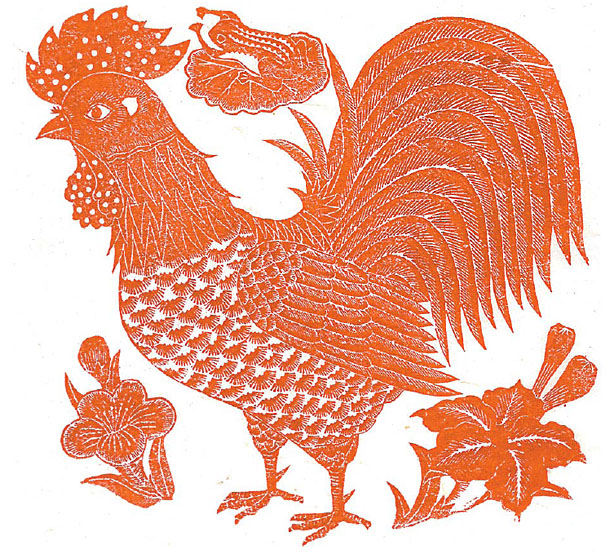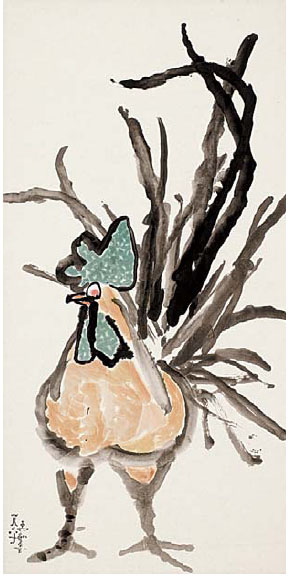Exhibits show the rooster’s place in Korean culture: Good destinations to visit during the long holiday weekend

This Taiwanese wooden rooster engraving is on display at the Museum of Ancient Asian Woodblock Prints. [MUSEUM OF ANCIENT ASIAN WOODBLOCK PRINTS]
Although both political battles and economic challenges from the previous year will continue on, the year of the rooster will bring at least a little temporary sunrise into a gloomy outlook.
The rooster has significance in local culture, often used as a symbol for good omens. Despite a coincidental bird flu outbreak, museums are dedicating special exhibitions to the zodiac animal representing 2017, which are interesting destinations for those looking to explore art during the Lunar New Year holiday weekend.

“Rooster” (1960) by the famous Korean-born French painter Lee Ungno (1904-1989) is on display at the Seoul Museum in Jongno District, central Seoul. [SEOUL MUSEUM]
Located inside Gyeongbok Palace in Jongno District, central Seoul, the National Folk Museum is holding a special exhibition called “Rooster - Greet the Dawn” until Feb. 20 at the museum’s Special Exhibition Hall II. This special display of over 50 art pieces is based on the theme of the rooster. Exploring legends and proverbs based on the animal, the exhibition provides a detailed look at the cultural significance of the rooster. Some of the pieces date to before the 19th century.
The exhibition is separated into three sections. The first, “Guardian of the West,” is dedicated to the rooster as one of the twelve animals of the zodiac and the watcher of the sunrise, representing the hours between 5 and 7 a.m.
One piece is a painting of Mihira by the Buddhist monk Manbong. According to legend, Mihira is one of twelve zodiac generals that serve Bhaisajyaguru, the Buddha of medicine.
The second section explores five virtues related to the rooster.
In “Embracing the Five Senses,” arts and craftworks examine the virtues of intelligence, bravery in battle, courage, benevolence, and trustworthiness as said to be embodied in the animal, according to Chinese literature.
In the final section of the exhibition, “Companion to Everyday Life,” the museum displays typical household fixtures from older generations such as silverware, bowls, woodblock prints, and more. One such example is the gyeyi, a large jar meant for ancestral rites from the Joseon Dynasty.
The exhibition is being held until Feb. 20. Entrance is free of charge. Call 02-3704-3114 for more information.
Museum of Ancient Asian Woodblock Prints
The Museum of Ancient Asian Woodblock Prints located at the Myeongju Temple in Wonju, Gangwon, is offering its own exhibition dedicated to the zodiac animal.
The “Herald of Hope which welcomes the Dawn - Observing the World’s Rooster through Prints” is opening on Sunday and will be held until March 31.
“We planned this exhibition with the hope that our country will recover from its current chaos, just like the rooster that delivers the morning,” said Han Seok-hak, the museum director at a press conference on Tuesday.
The exhibition will consist of Korean woodblock engravings created by artists to represent fertility and abundance; Chinese Nian Hua, which are woodblock prints traditionally hung as decorations to celebrate the new year; Ukiyoe, which are woodblock paintings originating from Japan that depicts stories; and a variety of related artworks of European descent.
Such famous works to be displayed are “Rooster” (1938) by Spanish painter Pablo Picasso and “Le Cog avec le Bouquet Jaune” by the Russian-French artist Marc Chagall. Chagall in particular frequently used the rooster as imagery for fertility, and roosters are often seen in his pieces related to love.
“Visitors will be able to see the rooster in a new light through the artwork,” said the museum director.
Entrance costs 5,000 won ($4.28) for adults and 4,000 for children. Call 033-761-7885 for more information.
BY CHUNG JIN-HONG [chung.jinhong@joongang.co.kr]










with the Korea JoongAng Daily
To write comments, please log in to one of the accounts.
Standards Board Policy (0/250자)